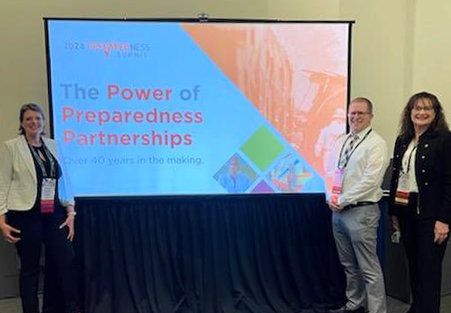Oswego County Partnership Highlighted at National Conference
“The Power of Preparedness Partnerships – Nearly 40 Years in the Making” was the topic of a presentation by three professionals from agencies within Oswego County at a national conference last month.
Sonia Robinson, senior public health educator and emergency preparedness coordinator with the Oswego County Health Department; Kathryn Pagliaroli, senior vice-president of clinical operations and chief nursing officer for Oswego Health; and Tyler Peet, emergency management coordinator at the Oswego County Emergency Management Office (EMO), collaborated on the presentation for the annual Preparedness Summit, organized by the National Association of County and City Health Officers (NACCHO) and held in Cleveland, OH March 25-28.
“Years of planning, training and full-scale exercises in collaboration with Oswego Health and EMO built a great partnership,” Robinson said. “This opportunity allowed us to share that knowledge with others throughout the country who have not enjoyed that level of cooperation.”
Oswego County Emergency Management Director Cathleen Palmitesso added, “We’re very proud of the longstanding partnerships and our ability to respond to and manage emergencies. This was an excellent opportunity to showcase what we’ve learned and how other agencies can build on partnerships in their communities.”
The three agencies began working together during the development of the Oswego County Radiological Emergency Preparedness Plan in the early 1980s following the nuclear power plant accident at Three Mile Island in Pennsylvania. The partnership between the county’s Emergency Management Office and Health Department and Oswego Health were nurtured and expanded throughout the next decades, through the aftermath of 9/11, pandemic flu (H1N1) response, and record lake effect snowstorms. The partnerships were tested by the COVID-19 pandemic, which stressed the health care system and the community.
“Planning together and participating in training and exercises really cemented the partnerships,” said Pagliaroli. “We really had to work even better together to make sure COVID-19 testing and vaccinations reached the community. The Emergency Operations Center briefings, which Oswego Health had never really been part of before, were an important avenue to share information and strategies and know what all of the response agencies were doing.”
Oswego County Associate Public Health Educator Diane Oldenburg said, “This collaboration among our three agencies gave us an opportunity for the county to showcase the 40-plus years of planning, training and responding to emergencies in a rural, low-income environment.
“Health Department staff have been attending this conference for several years and have given presentations on the success of exercises simulating distribution of medicines in an emergency that used an actual product – Girl Scout cookies – to test the plan,” she continued. “The annual summit draws together more than 2,500 health and emergency management officials to share best practices, build partnerships, and take away innovative solutions and practical strategies to address the vulnerabilities in the nation’s health security system.”
Peet, who joined the Emergency Management Office in August 2023, said, “The opportunity to work with Sonia and Katie and to learn about the history of health care and emergency management in this county was tremendous. It was a great opportunity to further the partnerships we’ve created and share experiences about how the events unfolded.”
The presentation focused on partnerships as they expanded during the start of the current Radiological Preparedness Program.
“Oswego County was the first to have its radiological emergency plan approved by the Federal Emergency Management Agency in 1985,” Palmitesso said. “The plan was developed following the Three Mile Island nuclear power plant accident in 1979. The lack of cooperation and coordination among governments and response agencies during the accident response added to the stress and confusion in the community. The county radiological emergency plan was designed not only to ensure the protection of the public in such an emergency but also to ensure agencies worked together on a common goal and provide clear, accurate, timely and concise public information.”
The joint presentation also highlighted how the amount of time to plan for emergencies continues to shrink, as does staffing and funding.
“That’s why now, more than ever, it is important to form those partnerships (if they don’t already exist) and enhance them if they do,” Peet said. “So, get out from behind your desk and start building those relationships. And start with those who share a common mission with you, and for most of us, that is ‘people first.’”
Peet pointed out that developing strong interpersonal connections and trust among partners facilitates effective communication, resource-sharing, and coordinated action during emergencies, ensuring a seamless response and recovery process across disciplines. Also, regularly conducting joint exercises and simulations allows stakeholders to test and refine their collaborative strategies, identify gaps, and strengthen their collective capacity to respond to diverse public health threats, ultimately enhancing preparedness and resilience within the community.
LOCAL PARTNERSHIP AT NATIONAL SUMMIT – Kathryn Pagliaroli, senior vice-president of clinical operations and chief nursing officer at Oswego Health; Tyler Peet, emergency management coordinator at Oswego County Emergency Management Office, and Sonia Robinson, senior public health educator and emergency preparedness coordinator at Oswego County Health Department, focused on “The Power of Preparedness Partnerships – Nearly 40 Years in the Making” at the recent Preparedness Summit hosted by the National Association of County and City Health Officers in Cleveland, OH.




